
Dallas Cowboys Offense: Press Man Coverage
Unsurprisingly, press coverage prevails again. When Tyron Smith was absent forcing Terrence Steele to the left side of the offensive line, press coverage has given opposing defenses enough time to get to quarterback Dak Prescott in the pocket as it naturally takes longer for wide receivers to release against press coverage.
The Broncos have the talent at cornerback to consistently and effectively press even against the Cowboys’ great receiving corps. The Chiefs might not have the talent, but they did show their competitive toughness and swagger all throughout the game. Las Vegas’s front four is good enough to generate pressure on their own. (Whether we choose to admit it or not, Rod Marinelli is still a good DL coach)
Denver, Kansas City, and Las Vegas elected to play press coverage all game. The Broncos had the talent to play man coverage against Dallas’s starters while the Chiefs and Raiders had an easier time against Dallas’s fourth and fifth receivers.
From there, Denver and Kansas decided that they would challenge individual matchups. By playing press man coverage, they forced smaller windows of separation instead of forcing Prescott to locate soft spots, something he does quite well!
With good protection, press coverage is far less problematic. That, however, leads me to my next point.
Stacking the Box
Vic Fangio, at the beginning of week 9, said they wanted to stop Dallas from running the ball. Steve Spagnuolo didn’t repeat this at the beginning of week 11, but he did the same thing. While the offense generated yardage against Atlanta and Las Vegas, the team has been quite bad at running the ball the last four games.
What gives?
Defenses are getting comfortable stacking the box against and playing their defensive linemen close together and offset to one side. When the Cowboys want to run the ball, they’re forced to run the ball to the weak side and don’t always have enough blockers to account for roaming defenders.
Dallas doesn’t use the pre-snap motion we’re used to seeing from Shanahan offenses. However, to force defenders out of gaps, they do use formation shifts to play with defenders hoping that looking at a new formation with less than 15 seconds on the play clock forces them to incorrectly line up in a gap.
In every sense of the phrase, the Cowboys really are “playing to what the defense gives them.” But what happens when the defense gives you the same stacked box look and you still want to run it? You’re likely looking at nothing better than a two-yard gain.
The last four weeks Cowboys running back Ezekiel Elliott has only averaged 10.5 attempts per game at 3.55 yards per carry. (Carry total being low is partially due to injury, but the efficiency is quite bad regardless) This is quite the stark contrast to the previous seven games where Elliott averaged 5.1 yards per carry. Defenses realized that not respecting the run enough was leading Dallas to the top of the charts in rushing efficiency.
The obvious issue now is that Dallas wants to run as they have in the past while expecting something they aren’t achieving. The long yardage on third down and the blitz-heavy looks Prescott is getting are tanking his efficiency and aren’t providing him with the balance and rhythm every quarterback needs in order to keep their offense moving.
Drops
Not much to say here. Drops can’t keep happening at the rate they are! Drops are the reason the Cowboys can’t get favorable positioning on second-and-long and keep them off the field after they can’t convert on third down.
However, there isn’t anything strategically the team can do to reduce drops. But, what about the other things?
